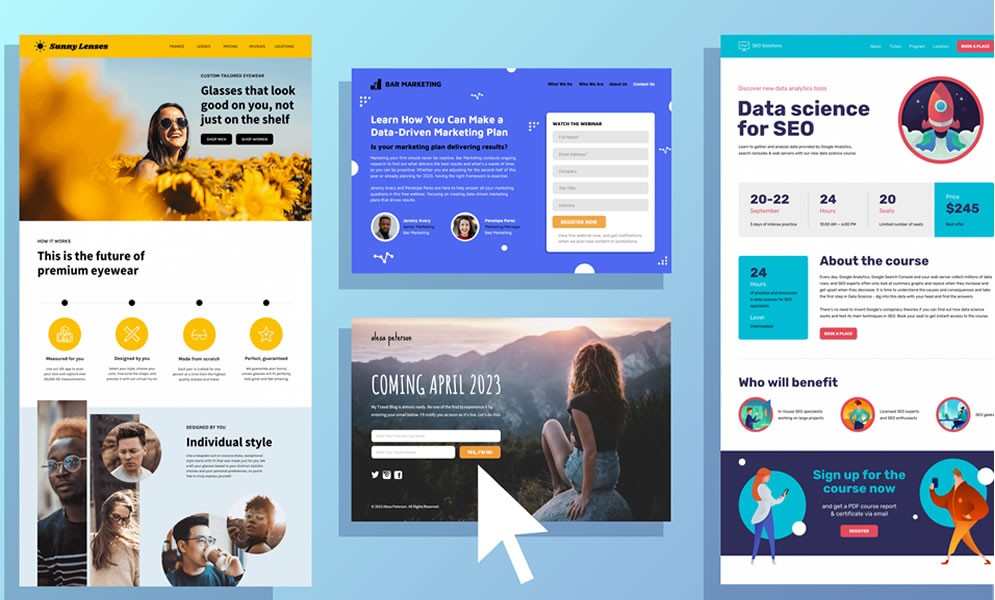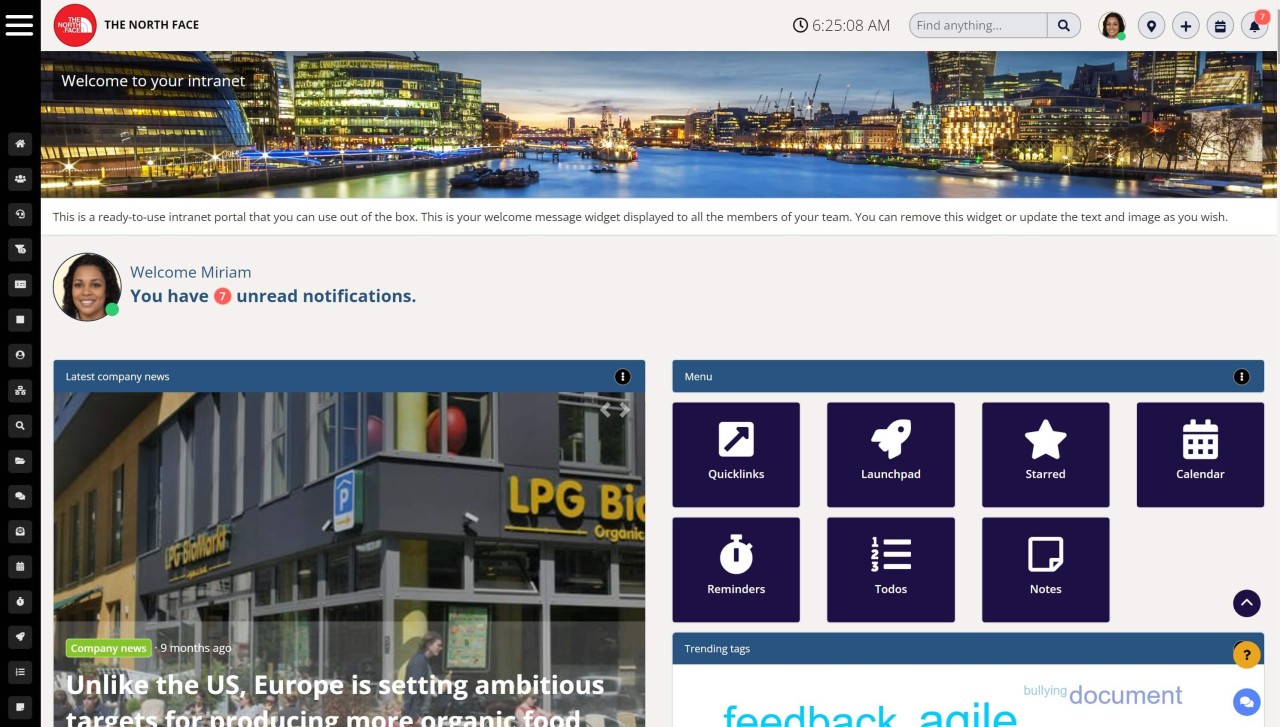Insight Blog
Agility’s perspectives on transforming the employee's experience throughout remote transformation using connected enterprise tools.
10 minutes reading time
(1918 words)
Intranet landing pages: Tips to make them engaging and relevant
Good intranet homepage provides quick access to what employees need the most. Here are intranet landing pages ideas that can keep employees engaged.
Users are the ultimate arbiters of an intranet solution's value. That's why it's important to conduct internal research to learn what information your staff really needs before designing an intranet. Intranet landing pages that do their job well aren't just a quick stop for visitors on their way to the "real content." Correctly designed landing pages serve as a one-stop shop for all the useful information, applications, and data workers require to perform their jobs.
This article will discuss methods for creating content that employees will find interesting and useful.
One page landing page examples
A landing page is a web page that allows you to capture a visitor's information through a web form. Typically, a landing page will have a single call-to-action, such as "Submit your email to download our new white paper."
The goal of a landing page is to collect information from your visitors so that you can follow up with them and continue the conversation. By providing valuable content, you can turn a one-time visitor into a lifelong customer. High-converting landing page designs are essential for any business that wants to grow its online presence. If you're not using landing pages, you're missing out on a huge opportunity to capture leads and drive sales.
Here are three examples of businesses that are killing it with their one page landing pages:
- Freshbooks: This Canadian accounting software company uses a simple but effective design on their landing page, which features a strong headline, customer testimonials, and a clear call-to-action.
- Slack: The popular messaging app uses a clean and minimalist design on their landing page, which helps communicate their value proposition quickly and effectively.
- AutoGravity: The German car financing startup uses an eye-catching video background on their landing page, along with clear copy and a strong call-to-action.
A few easy-to-use platform makes it simple to build and test different versions of your page so you can find the perfect recipe for success. Now lets get into intranet landing page design and the main elements to focus on to make them just as engaging as web pages.
Intranet home page
When it comes to intranet design employees appreciate well-thought-out landing and home page designs that feature relevant metrics and KPIs, highlights of relevant company news, updated documents, links to frequently used applications, and more. The general idea is that sections like "Company Communications Team," "Department Communications," and "Human Resources" should all have prominent placement on the homepage.
You can also add things like user-generated content, urgent alerts, company news and events, and department-specific updates.
4 key elements:
Intranets can be a powerful tool for businesses, providing a central hub for employee communications and collaboration. However, an effective intranet requires more than just a few pages of text and some links. To truly engage employees and encourage them to use the intranet on a regular basis, there are four key elements that must be included on the home page:
- A clear purpose: The home page should clearly state the purpose of the intranet and how it can benefit employees.
- Easy navigation: Users should be able to easily find their way around the site with intuitive navigation.
- Relevant content: The content on the home page should be relevant to employees and reflect their needs and interests.
- A sense of community: The intranet should foster a sense of community by featuring user-generated content and encouraging interaction between users.
By including these four elements on the home page, businesses can create an engaging intranet that employees will actually want to use.
Create an optimal user experience (UX)
User retention and repeat visits are directly proportional to the quality of the user experience (UX). Using user experience design principles like keeping pages straightforward and including calls to action, developers can make intranet homepages that staff rave about.
Bear in mind that UX is neither an art nor a science. The approach is more crucial. The best way to learn UX is to dive right in and start experimenting. Just release both versions of the page for testing. Take note of the lessons it can teach you and make adjustments where necessary.
Point to consider:
- Keep it simple: Complex intranets can be overwhelming and frustrating for users. Keep navigation simple and intuitive to help users find the information they need quickly and easily.
- Make it visually appealing: People are visual creatures, so make sure your intranet is attractive and easy on the eyes. Use colors, graphics, and other visuals to break up text and add interest.
- Use engaging content: Dull, boring content will only serve to frustrate users. Write engaging content that is easy to read and provides value.
- Foster collaboration: Encourage users to interact with each other on your intranet by adding features such as forums, chats, and blogs.
- Get feedback: Continuously gather feedback from users to identify areas where the intranet can be improved. Make changes based on this feedback to ensure that your intranet is always meeting the needs of your employees.
Show relevant information only
Don't overcrowd the page with widgets just because you can. A busy page is no guarantee of useful content. The value of landing pages can be reduced if visitors don't appreciate the extra touches that were made. Don't bloat the app with features nobody wants.
Try showing a section labeled "My Work" or "My Favorites." As a result, the odds improve that this information will be more useful to that user than a more general roundup would be.
Point to avoid dumping content:
- Define its purpose. Before launch, take some time to think about what you want your intranet to achieve. Is it primarily for sharing documents? For communication? For project management? Once you know its purpose, you can put systems in place to ensure it is used effectively.
- Keep it tidy. An organised intranet is a usable intranet. Make sure documents are filed in logical folders, and that old or unused items are deleted on a regular basis. Encourage users to keep their own areas tidy, and consider appointing a 'intranet champion' to oversee organisation.
- Only allow relevant content. One of the main reasons intranets become cluttered is because they are filled with irrelevant content. When adding content to your intranet, ask yourself whether it is truly useful for your users. If not, leave it out.
- Review regularly. As your business changes, so too will your intranet needs. Review the usage and effectiveness of your intranet on a regular basis, and make changes as necessary. By following these tips, you can ensure your intranet remains a valuable asset for your business.
Keep the user engaged
You can keep the user engaged if you start with the most important information. This focus on current events demonstrates that contemporary authors do not exclusively draw from academic research. The book "Made to Stick" by Chip and Dan Heath provides a clear explanation of this concept. The most crucial information should be presented first, and the rest of the paper should be constructed around it.
Even though you probably won't be using a lot of quotations on your intranet pages, the principle is the same. Put the most vital information up front, and keep the reader interested so they keep on scrolling.
How to keep users engaged:
- Keep content fresh: No one wants to log onto an intranet that hasn't been updated in months. Make sure to regularly add new content, whether it's company news, employee spotlights, or helpful tips and tricks.
- Encourage collaboration: An intranet can be a great platform for employees to collaborate on projects and share ideas. Use it to your advantage by creating forums and chat rooms where users can engage with each other.
- Make it user-friendly: An intranet should be easy to navigate and use. That means having a clear layout with logical menus and intuitive tools. If users can't figure out how to use your intranet, they're not going to bother logging on.
- Offer incentives: Finally, offer incentives to users who log onto the intranet regularly. This could be anything from prizes and discounts to early access to new features. Whatever you choose, make sure it's something that will motivate your team to stay engaged.
Update regularly and keep content fresh
It's also important to have someone updating the content regularly so as to avoid having too many features. The content of your homepage, for instance, should always be current because of its prominence. Homepage content is typically skimmed. If content appears dated, readers will begin to skip over it. If the page hasn't been updated in a few months, visitors will give up on it entirely. Knowing who is responsible for updating content is an important part of maintaining its currency.
Focus on making the content interactive
One practical strategy for doing so is to make the intranet content as interactive as possible. Offering employees the chance to interact with content in the same way they do on social media (by discussing, commenting on, or sharing it) is a surefire way to get them interested. The use of blogs, online communities, shared office space, and real-time news feeds are all examples of tools that could help with this.
Make an effort to use your imagination as well. Quizzes, surveys, and polls are not only entertaining ways to increase employee engagement but also serve a practical purpose. A simple poll where employees can vote on the best time and day for team meetings is a great way to get input from everyone. Employees will feel valued because you can provide immediate feedback on the results through the company intranet.
Do not focus on text only
Most of the time, we ignore the visuals in favor of the words. Most people don't read every word of text because they'd rather not. Indeed, studies have shown that only 28% of text displayed on a computer screen is actually read.
Use graphics, photographs, or trendy images wherever possible to break up large blocks of text and make the content more visually appealing. Indeed, a picture can often say much more than a page of text.
Communication of complex information, such as health and safety procedures, can be simplified and expedited with the help of a flow chart. Two or three pages of copy would be needed to convey the same information.
Targeted and personalized content
Members of staff frequently split their time between multiple offices and responsibilities. It must reflect that if you want people to take your homepage seriously.
Consider the case of company announcements. A phone system failure would be a major disruption for people working in a single location. It's just noise to anyone who isn't there. A higher percentage of users will read your content if you focus on current events and news stories.
Conclusion
Your work doesn't end here either! To keep your employees interested and satisfied, it's important to check in with them and hear their thoughts on a regular basis. This is why employee feedback is important. This will help you maintain focus as you work to create interesting and useful content for the company intranet.
Categories
Blog
(2600)
Business Management
(319)
Employee Engagement
(211)
Digital Transformation
(174)
Growth
(119)
Intranets
(110)
Remote Work
(61)
Sales
(48)
Collaboration
(36)
Project management
(29)
Culture
(28)
Customer Experience
(26)
Knowledge Management
(21)
Leadership
(20)
Comparisons
(6)
News
(1)
Ready to learn more? 👍
One platform to optimize, manage and track all of your teams. Your new digital workplace is a click away. 🚀
Free for 14 days, no credit card required.
















